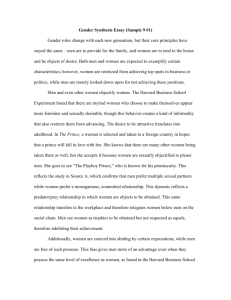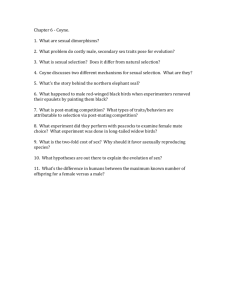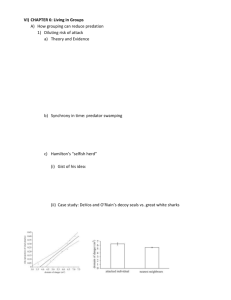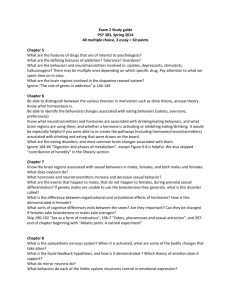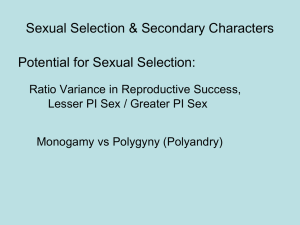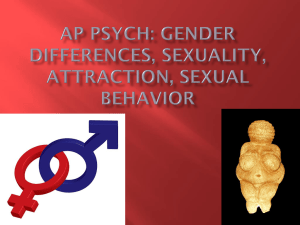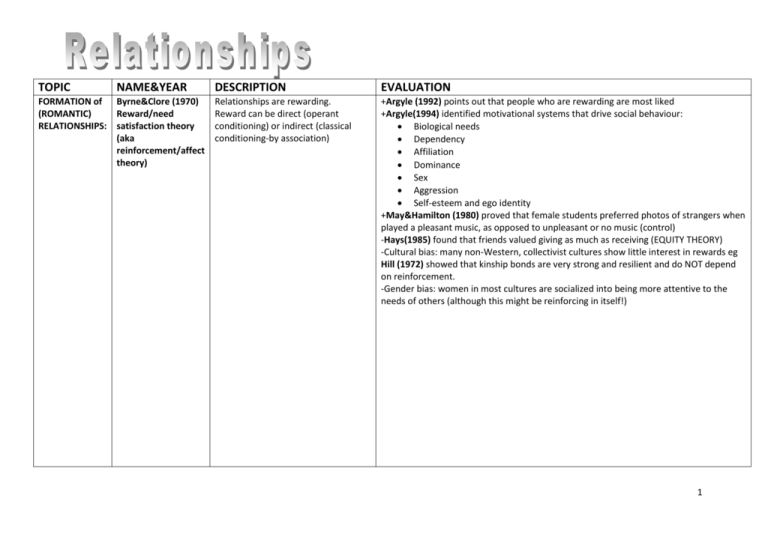
TOPIC
NAME&YEAR
FORMATION of Byrne&Clore (1970)
(ROMANTIC)
Reward/need
RELATIONSHIPS: satisfaction theory
(aka
reinforcement/affect
theory)
DESCRIPTION
EVALUATION
Relationships are rewarding.
Reward can be direct (operant
conditioning) or indirect (classical
conditioning-by association)
+Argyle (1992) points out that people who are rewarding are most liked
+Argyle(1994) identified motivational systems that drive social behaviour:
Biological needs
Dependency
Affiliation
Dominance
Sex
Aggression
Self-esteem and ego identity
+May&Hamilton (1980) proved that female students preferred photos of strangers when
played a pleasant music, as opposed to unpleasant or no music (control)
-Hays(1985) found that friends valued giving as much as receiving (EQUITY THEORY)
-Cultural bias: many non-Western, collectivist cultures show little interest in rewards eg
Hill (1972) showed that kinship bonds are very strong and resilient and do NOT depend
on reinforcement.
-Gender bias: women in most cultures are socialized into being more attentive to the
needs of others (although this might be reinforcing in itself!)
1
attraction
Walster et al. (1966)
Matching hypothesis
of attraction
MAINTENANCE Homans (1971)
OF (ROMANTIC) Social Exchange
RELATIONSHIPS: Theory (SET)
ECONOMIC
THEORIES
The more socially desirable a
person is, the more they would
expect a potential partner to be
Couples who are matched are
more likely to have happy,
enduring relationships
“Realistic choices”: when choosing a
partner, individuals are influenced by
Desirability of potential match
Probability of the other person
saying “yes”
Relationships involve rewards BUT
ALSO costs (eg money, time,
emotional distress...).
Satisfaction from relationship
depends on the ratio between costs
and benefits (rewards) - the
‘OUTCOME’.
If rewards outweigh the costs, there is
PROFIT. Vice versa, there is loss,
which leads to dissatisfaction.
People are basically selfish, aiming to
MINIMISE COSTS and MAXIMISE
REWARDS.
-Walster et al (1966) The computer dance study: 752 students believed they had been
matched with a partner (but they had been matched RANDOMLY) for a date.
FINDINGS: all PPs reacted more positively to more physically (not intelligence, class,
personality) attractive dates and were more likely to try to arrange further dates. There
seemed to be no concern of rejection.
+ Murnstein (1972) argues that even if, in theory, we desire more attractive partners, IN
REALITY we go for someone at our own level; studied 99 couples who were dating and
compared them to randomly paired couples – found that real couples were rated as
physically similar.
-doesn’t consider arranged marriages and influence of third parties
-Hatfield&Sprecher(2009)complex matching states that people are matched in terms of
SOCIAL DESIRABILITY (not only physical attractiveness) – this is more reflective of the real
world
-gender differences: men value physical attractiveness more than women (evolutionary
theory)
+ Thibaut&Kelley (1959) 4-stage model to develop further SET:
Sampling
Bargaining
Commitment
Institutionalization
PLUS:
comparison level (CL): what previous partners had to offer
comparison level for alternatives (CLAlt): benefits of possible alternative
relationships
2
Walster (1978)
Equity theory
Explains how SET works in REAL LIFE:
people strive to achieve fairness and
are distressed if they perceive
unfairness.
4 principles:
1. people try to maximise rewards
and minimize costs
2. distribution of rewards is
negotiated to ensure fairness
3. unfair relationships produce
dissatisfaction
4. as long as the ‘loser’ feels there
is a chance of restoring fairness
and is motivated to save the
relationship, he/she will
endeavour to re-establish equity
Rusbult (1983)
Investment model
The level of commitment predicts the
likelihood of the relationship being
maintained.
Commitment is increased by the level
of satisfaction derived from the
relationship and weakened by the
presence of possible alternatives to
the relationship.
Also INVESTMENT increases
commitment.
INVESTMENT= anything a person puts
into a relationship that will be lost if
they leave it
-Contrived methodologies and limited application: lack of ecological validity
-Feeney et al (1994) found that equity theory failed to predict relationship satisfaction
because it doesn’t consider the variance in context of modern-day relationships
-Lack of consistent empirical support: Clark&Mills (1979) identified 2 types of couples
‘communal couple’: positive regard for the other motivates giving
‘exchange couple’
-gender differences: Prins et al (1993) interviewed Dutch couples and found that women
were more likely than men to consider (or have)an affair due to perceived inequity in the
relationship
+van Yperen&Buunk (1990) longitudinal study on 259 couples recruited from newspaper ad.
They obtained a score for equity in the relationship using Hatfield’s Global Measurement of
Satisfaction and found that 65% found their relationship equitable; 25% of men felt overbenefited; 25% of women felt under-benefited.
One year later, couples were asked about satisfaction in their relationship: those who felt the
relationship was equitable were most satisfied, then the over-benefited and the underbenefited were the most dissatisfied!
-ethical issues with using interviews on a sensitive topic as relationships
-cultural bias: equity seems to be more important in Western, individualistic cultures
-most people in relationships do not carry out the exercise of counting costs and benefits
+Rusbult (1983) asked college students in heterosexual relationships to complete
questionnaires (on satisfaction, alternatives, investment+feeling of commitment) over a 7month period. Those with higher satisfaction and investment were more committed to the
relationship.
+Le&Agnew(2003) meta-analysis of 52 studies on over 11000 PPs in 5 countries on BOTH
HETEROSEXUAL AND HOMOSEXUAL couples. Confirmed Rusbult’s theory. Highest
correlation was between SATISFACTION and COMMITMENT. No gender differences, but
correlation between investment and commitment was stronger in heterosexual men.
Correlation between alternatives and commitment was stronger for lesbian than
heterosexual women.
-meta-analysis relies on only PUBLISHED research (some research with negative outcomes
may never be published-RESEARCHER BIAS)
3
BREAKDOWN
Duck (2006)
OF ROMANTIC
RELATIONSHIPS
(note: SET and
Equity theory
can also be used
to explain
relationship
breakdown!!!)
Lee (1984)
Focus on the processes that occur
during relationship breakdown: these
can overlap or have common aspects,
but have different purposes and
outcomes.
These processes are:
1. Breakdown (‘I can’t stand this
anymore’) - dissatisfaction
2. Intrapsychic (‘I’d be justified if I
left’)-social withdrawal
3. Dyadic (‘I mean it’)-confrontation
4. Social processes (‘It’s now
inevitable’)-made public
5. Grave-dressing (‘Time to get a
new life’)
6. Resurrection (‘What I learned and
how things will be different’)
5 stages of relationship breakdown:
1. Dissatisfaction
2. Exposure
3. Negotiation
4. Resolution attempts
5. Termination
-There are strong gender differences in relationships that have not been considered (see
evolutionary theory below)
+as opposed to previous theories, that have focused on the distress caused by break-ups,
this model considers the potential for growth (resurrection process)
-however, there are gender differences also in the levels of personal growth: women
report more post-relationship growth than men
-Akert (1998) found that the role people played in the decision to end the relationship
was the single most powerful predictor of the impact of the experience: the partner who
doesn’t decide to end the relationship is generally more miserable, lonely, depressed,
and unhappy.
-heterosexual bias: the theory has been developed drawing n the experience of mostly
White, middle-class, heterosexual couples (not representative->low generalisability)
-doesn’t explain WHY relationships break down, only HOW
+ Lee found the following stages from a survey of 112 breakups of premarital romantic
relationships. He found that the relationships that had been the strongest took the
longest time to work through the five stages.
-Doesn’t explain why relationships break down
-Felmlee’s ‘fatal attraction’ theory suggests another reason for breakup – the same
characteristics that initially attract us to a person ultimately lead to dissolution – they
might be exciting or different to start with, but then later be predictable, or strange.
-Research in non-Western cultures found differences between those and Western
cultures. Moghaddam et al. (1993) found that North American relationships are mainly
individualistic (concerned with the needs of the self), voluntary and temporary (the
majority of relationships are able to be terminated). Most non-Western relationships are
collective (concerned with the needs of other, e.g. kin), obligatory and permanent.
4
Evolutionary
explanations of
relationship
breakdown
Women prefer mates with
resources, however this assumes
that men are willing to share
these resources with them. As
these resources are very
important to females, female
rejectees will experience higher
costs associated with losing the
emotional investment of their
partner.
As females value emotional
commitment, males threatened
by a break-up might increase
commitment as a strategy to
maintain sexual access.
Buss (1993) shows that males
prefer sexual variety, so sexual
infidelity is more likely in males,
and can be used as a tactic to end
the relationship or to find a
replacement prior to the breakup.
Reputational damage – those
who end the relationship might
be perceived negatively by their
peers, and any damage to their
reputation might affect their
chances of mating in the future.
This might motivate individuals to
behave sympathetically towards
their partner during the break-up!
+Perilloux&Buss(1998) adapting nature of coping behaviour following break-up: 98
males and 101 males from US university who had experienced at least 1 break-up. All
heterosexual and 69% White Caucasian; they all completed a questionnaire.
Females reported higher costs with losing their partner’s emotional commitment
More males reported success at preventing a break-up by increasing their level
of commitment
Male rejectors more than female rejectors reported engaging in sex with others
prior to break-up
Rejectors reported a higher cost of being seen as cruel and hartless rather than
the rejectees
-PPs were unrepresentative due to age, cultural origin, sexual orientation, and
occupation
-self-report data might be unreliable (social desirability bias)
-Nichols (1985) argues that evolutionary explanations focus solely on ultimate causes and
neglect important contemporary causes, such as cultural factors and impact of tradition.
5
SEXUAL
SELECTION AND
HUMAN
REPRODUCTIVE
BEHAVIOUR
Sex differences in
human mate
preferences
The evolutionary basis of mate
selection implies that mate choice
depends on potential reproductive
success.
Also physical attraction will depend
on those characteristics that increase
chances of survival.
Darwin (1871) - sexual selection
(complements the force of natural
selection): competition for mates
between individuals of the same sex
affects the evolution of certain traits.
Certain traits increase chances of
mating, so are retained even if they
are not necessary for survival (eg
peacock’s tail).
+Buss(1989) studied 37 cultures in 6 continents and 5 islands on over 10000 people of different
religious, ethnic, and economic groups. Sampling procedures varied by country. Data was then
analysed in the US.
Women of all cultures showed a preference for men with resources or potential to achieve
them
Men universally placed more emphasis on physical attractiveness – indicator of woman’s
health
Men of all cultured desired a partner that was younger than them (approximately under 25
years old)
Both sexes universally wanted partners who were intelligent, kind, and dependable
+Anderson (1986) found that fertility in females may peak earlier than previously thought (mid
twenties) suggesting that males value fertility more than reproductive value (potential childbearing years)
-Sample might not have been representative for all cultures (eg rural and less well-educated
people were under-represented)
-Doesn’t consider the fact that in some cultures arranged marriage is the norm
-Different methodologies had to be used in different cultural contexts
+Cunningham (1986) investigated which female faces were attractive to males: he systematically
varied the size of female facial features (eyes, noses, chins) and found that men found most
attractive features associated with youth (eg big eyes, small chin...)
+Langlois et al (2000) carried out a meta-analysis of 919 studies into physical attractiveness and
found that there was considerable agreement between cultures on attractiveness. Even in
children!!! (as early as 26 months old)
+Singh (1993) body shape- WHR(waist-hip ratio)- women who had 0.7 WHR were considered
universally more attractive. Larger hips suggest higher reproductive potential.
+Dunbar & Waynforth (1995) analysed 900 personal ads from North American newspapers
Seeking younger partner - 42% men vs 25% women
Importance of physical attractiveness - 44% men vs 22% women
+Kenrick et al (1995) analysed 783 single ads from a range of NY magazines found that
gay and straight men had very similar preferences
Both happy to have an older partner (up to 5 years) when in their 20s but then
went gradually towards younger partners
6
Sex differences in
reproductive
behaviour
Tendency to engage in casual sex
– males are more likely to engage
in casual sex as it increases their
chances of reproduction
Men seek and desire a greater
amount of sexual partners
Differences in sexual jealousy
Sexual fantasies and dreams
+ Tendency to engage in casual sex
Buss & Schmitt (1993) found men are more likely to engage in short-term and
one-night stands
Clark&Hatfield (1989 and 1990) a male or female approached students asking
▪ To go out that night
▪ To go back to their house with them
▪ To have sex with them
▪ Found that 50% of both men and women agreed to go out
▪ NO women agreed to sex
▪ 75% men agreed to sex (but only 69% agreed to go back to
house)
Also lesbians present similar unwillingness to engage in uncommitted sex
(Buss&Schmitt, 1993)
+Men tend to seek and desire a greater number of sexual partners
Buss & Schmitt (1993) asked number of ideal sexual partner
▪ Over next 2 years – M:8; W: 1
▪ Over a lifetime– M: 18; W: 4 to 5
+Differences in sexual jealousy
Men more stressed if partner sexually unfaithful
Women if partner was in love with another
+Sexual fantasies and dreams
Ellis & Symons (1990) found that men are more likely to have sexual dreams
than women, especially those involving multiple partners or strangers
7
Parental investment
theory (Trivers,
1972)
Parental investment=“any investment
made by the parent in an individual
offspring that increases the
offspring’s chance of surviving at the
cost of the parent’s ability to invest in
other offspring”
Female investment is much
stronger
+Females have less gametes (eggs) and reproduction is harder for them, so they invest more
+Increase in brain size has made childbirth harder, so human babies are born prematurely and
need extra care
+This also explains why women prioritise wealth in a potential partner (to take care of the
offspring)
+Mater simper certa est (the mother is always certain) – males can never be sure that the
offspring is theirs, therefore they invest less on them
+Buss (1995) suggests that sexual jealousy in men is caused by risk of investing on other’s
offspring
- HOWEVER, Harris(2003) found that male’s arousal levels increased at the sight of ANY sexual
imagery, regardless of its context!
+Geher et al (2007) asked 91 undergraduates who were not yet parents to complete a parental
investment perception scale, which measured how prepared they felt for parenthood.
Found no real difference between males and females
HOWEVER when males and females were exposed to a series of statements that showed a
need for parental investment (eg cancel a work appointment to be with a sick child) males
showed a higher ANS arousal compared to females, showing they were actually less prepared
for parenting
This could be explained by sexual strategies theory: males perceived parental readiness (as
opposed to actual parental readiness) can be explained by social desirability bias (coming
across as good potential parents would make them more desirable to females!)
-Anderson et al (1999) found that men did not discriminate financially between a child who was
born to a current partner from a previous relationship (stepchild) and their own child from a
previous relationship.
+However, this can also be explained by sexual strategies theory: men may invest in a stepchild in
order to convince the mother that he is a ‘good provider’ therefore promoting future mating
possibilities.
- Males DO help out
+Although it is in their interest to appear good parents!
+helps to explain mate preferences for males and females: Buss found that, overall, females
valued wealth and resources; and males valued looks and sexual fidelity!
+it explains why men are more likely to go for short-term sexual relationships
-however, in real life, also women engage in one-night stands etc. (this can be explained as “mate
insurance”) – sexual strategies theory
- doesn’t consider homosexual relationships (which are non-reproductive)
8
Parent\offspring
conflict - Trivers
(1974)
EFFECTS OF
EARLY
EXPERIENCE
AND CULTURE
ON ADULT
RELATIONSHIPS
The effects of
childhood
experiences on adult
relationships:
Bowlby
Every child wants more resources from
the parent than they’re prepared to
give
WEANING
Psychosexual stages of
development – oral stage
Failure to overcome stages
successfully results in FIXATION or
REGRESSION
Child will use psychological
weapons (eg temper tantrums) to
obtain parental investment
CONFLICT AT PUBERTY - INCLUSIVE
FITNESS (Flinn, 1989)
Women share only 25% DNA with
grandchildren
They share 50% with own children
So... It is more beneficial to have
another child than a grandchild,
especially if the child will require
investment
A consequence of inclusive fitness
theory is MOTHER-DAUGHTER
CONFLICT
Bowlby
Internal Working Model: schema
for relationships based on first
attachment that shapes future
relationships
Maternal deprivation hypothesis:
lack of relationship with primary
carer might result in maladaptive
antisocial behaviour
-Lack of evidence in human groups: most studies are on non-humans
-Data on parent-offspring relations is often collected unsystematically by anthropologists
-Samples are also often small and procedures are not standardized
+Flinn(1989) found evidence of mother-daughter conflict in a study in Trinidad: conflicts
were more likely if mother was still of reproductive age
+Alexander (1974) “parental manipulation”: parents teach morals to increase chances of
survival and reduce conflict
+Andrews (2006) found that suicide attempts were much more common among middleborn children: extreme attempt to maintain parental investment
+44 juvenile delinquent study (Bowlby, 1976)
+supported by evolutionary theory (social releasers): attachment is necessary for survival
+supported also by ethology (Konrad Lorenz): also in animals imprinting occurs (similar
to Bowlby’s critical period)
+supported by psychodynamic theory (Freud and early childhood trauma)
+ Continuity hypothesis: early childhood attachment style will remain consistent
throughout an individual’s life
-social learning theory: relationship style could be acquired through observation of role
models rather than shaped on attachment with primary carer
9
The effects of
childhood
experiences on adult
relationships:
Attachment theory
The effects of
childhood
experiences on adult
relationships:
Interactions with
peers
Influence of
adolescent
experiences on adult
relationships
Attachment theory
Mary Ainsworth found that
children had a secure or insecure
attachment with mother
early childhood attachment style
will remain consistent throughout
an individual’s life
As well as the relationship with
parents, also friendship can
aid/damage the effectiveness of
an individual in a romantic
relationship
Especially for adolescents,
friendship is key
+Hazan& Shaver (1987) “Love quiz” found a correlation between childhood attachment
style and adult romantic relationships
Moore (1997)
Study using 100 adolescents aged 14-15
She asked a close friend of each teen to rate their behaviour for social acceptability
FINDINGS
• secure teens less likely to engage in risky sexual activities
• BUT more likely to have had sex
CONCLUSION: secure attachments can “set up” adolescents to handle the
transition to adult sexual relationships
Simpson et al (2007)
Longitudinal study on 78 PPs
• Age 1- caregiver reported on child’s attachment behaviours
• Age 6 to 8- teachers rated interaction with peers
• Age 16- PPs were asked to describe their close friendships
• Young adulthood- PP’s romantic partner asked to describe relationship
FINDINGS: securely attached infants had higher levels of social competence,
closer to their friends, and more expressive and emotionally attached in
romantic relationships
In this stage, more time is spent
with peers than with family
Peer group is used to make the
transition to the adult world
Dunphy (1963) observed high
school students in Sydney finding
2 types of social groups
o The clique- same-sex group of
4-6 youths aged 12-14
o The crowd- larger group
made of several cliques,
mixed genders
+Qualter and Munn (2005) children learn about themselves as a result of their
experiences with other children
10
The nature of
relationships in
different cultures
Romantic love is universal
Distinction between arranged
marriages vs “love” marriages
Collectivist vs individualist
cultures
+Jankowiak&Fischer (1992) investigated on a sample of 166 hunting and gathering societies
and found
◦ Clear evidence of passionate, romantic love in most of them but one
◦ All experienced the anguish of infatuation!
◦ CONCLUSION: romantic attraction is universal
+ Pinker (2008) gives an evolutionary explanation for romantic love: those in long-term
committed relationships are less stressed, happier and have lower mortality rates!
-the researchers were anthropologists so their research is unsystematic
-there was one society that did not present romantic love
-the sample can be considered too small to draw significant conclusions
+Myers et al.(2005) asked 45 individuals (22 couples+1 widowed) living in India in arranged
marriages to complete questionnaire on marital satisfaction
◦ Compared to US, NO DIFFERENCE in marital satisfaction was found
◦ BUT there were cultural differences in criteria for defining a marriage successful!
◦ US gave more importance to love than India
+ Gupta and Singh (1982) compared love and liking in arranged vs ‘love’ marriages after 1, 5
and 10 years
◦ Studied 100 professionals in Jaipur (India), 50 from arranged and 50 from ‘love’
marriages
◦ In ‘love’ marriages: liking and love were higher at start but both decreased with
time
◦ In arranged marriage: love and liking were low at start but exceeded ‘love’
marriages at 10 years!
+Wiederman (1991) asked US college students if they would marry someone “perfect” for
them but that they didn’t love
◦ 14% males said yes
◦ 9% of females said yes
+Sprecher et al. (1994) asked American, Japanese and Russian students
◦ Japanese and Americans were both reluctant
◦ Russians, specially women, were more “practical”
+Levine et al. (1995)
◦ Only in traditional collectivist cultures such as Thailand, India and Pakistan students
were willing to marry someone they didn’t love
11
sub-cultural
differences
Permanent vs impermanent
relationships (is divorce seen as
an option?)
Understudied relationships: gay
relationships
+Betzig (1989) studied most common reasons for divorce in 160 countries
◦ infidelity (women’s mostly), sterility, cruelty and/or maltreatment
+Huang (2005) explains increase in divorce in Asian countries
◦ Rapid urbanization and changing cultural norms (stress of modern life)
◦ Enhanced choice through education/employment
◦ Loosening of social control over marriage
◦ Increased leniency in divorce laws
◦ Importance of romantic love
◦ Growth of individualism
Internet (cyber) relationships
Similarities: May share values goals experiences and factors influencing formation,
maintenance and breakdown of relationships.
Differences: Social pressures sex role interactions-no pressure all is equal between
partners, but there may be less cohabitation and sexual exclusivity.
Similar influences in the formation and maintenance of other relationships e.g.
Exposure and familiarity effects (‘intersection frequency’ Wallace, 1999)
Similarity of belief effect (aided by common interest from post boards etc)
Electronic relationships are reported to be just as deep and meaningful as other
relationships (even more so sometimes).
12

